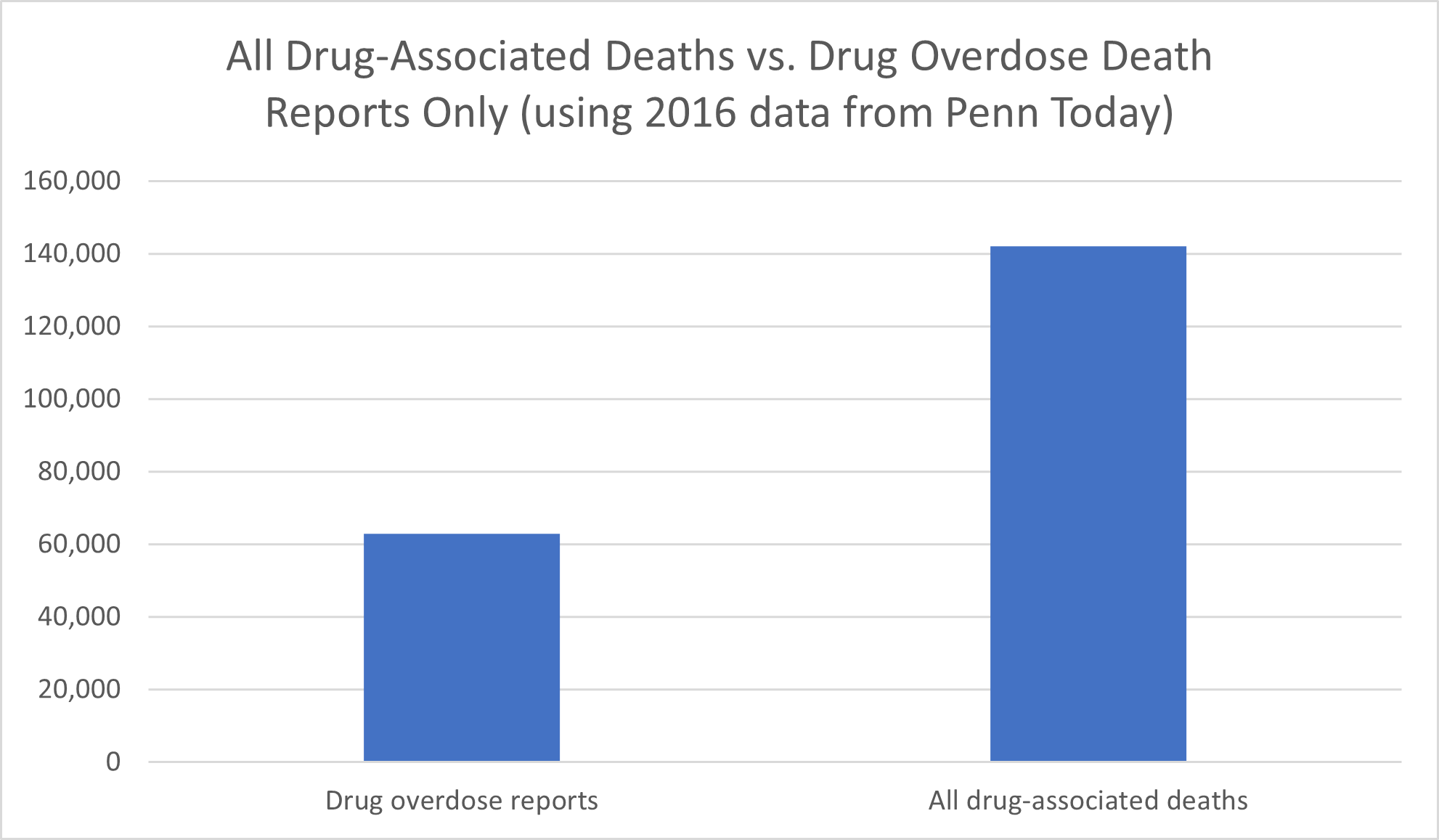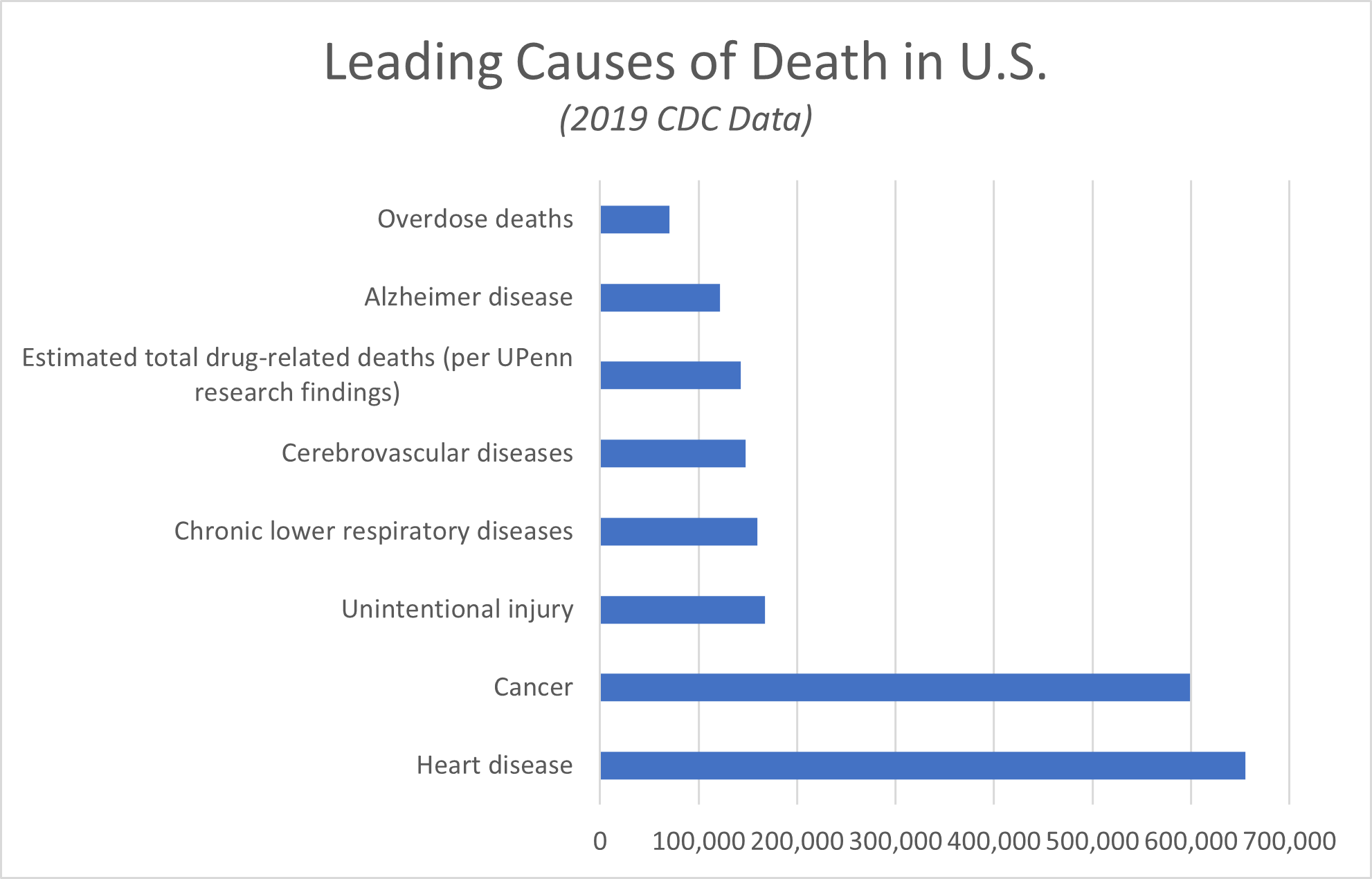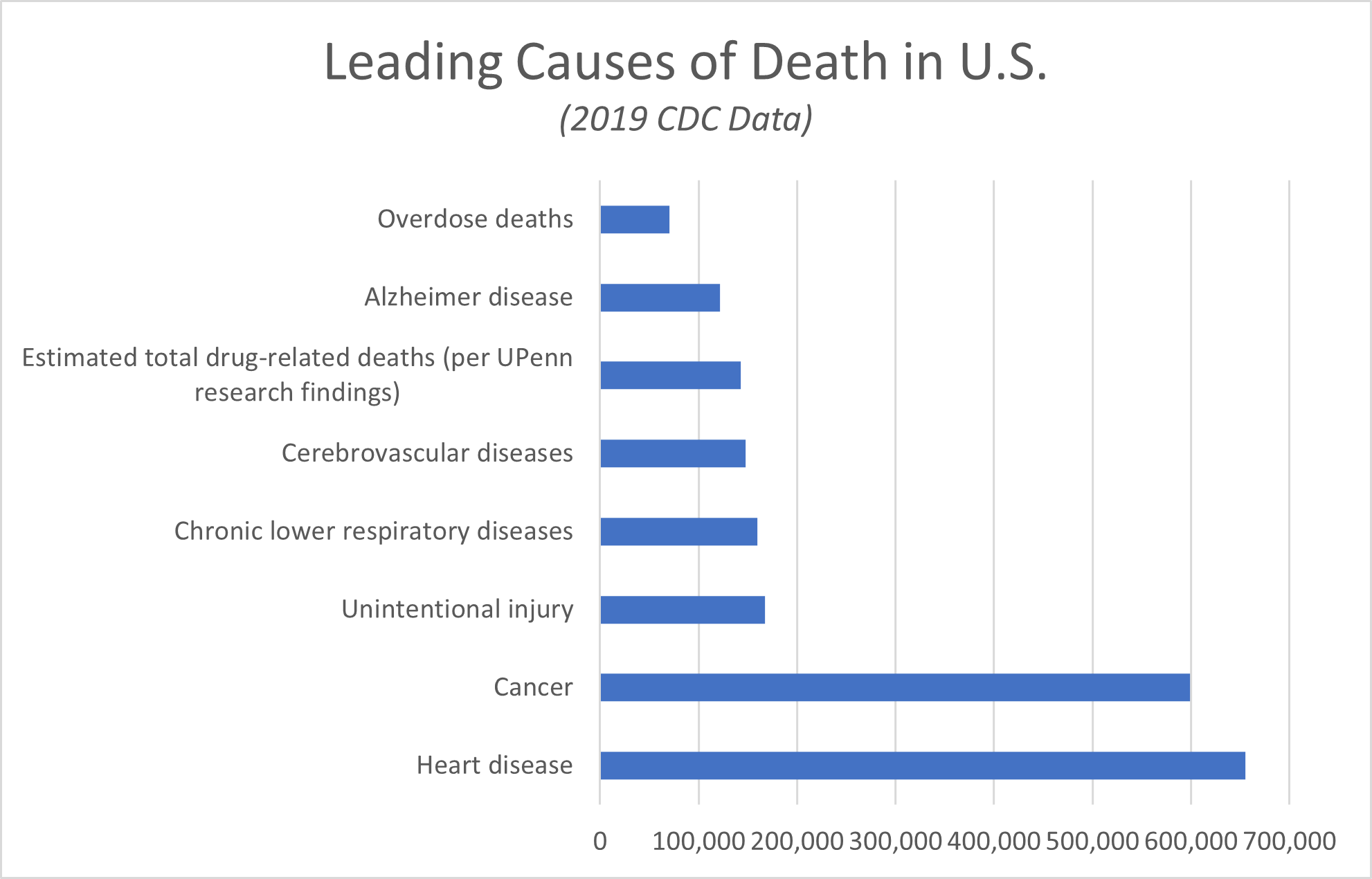If you’ve heard the claim that pharmaceutical drugs are a leading cause of death in the United States, you might wonder if it’s true.
There are thousands of prescription pharmaceutical drugs on the market today, not to mention over-the-counter medicines available without a prescription. Without question, pharmaceutical drugs contribute to deaths and economic costs in America—the question is, to what extent?
Based on the data available, it can reasonably be extrapolated that close to a quarter million people a year die in the US because of pharmaceutical drugs being taken, whether in error or as prescribed, putting pharmaceutical drug-related deaths as the third leading cause of death behind cancer and heart disease.
Pharmaceutical Drug Death Rates
Different health statistics concentrate on different types of deaths or mechanisms of harm. For example, opioid-involved overdose deaths—both among people using these medications as intended and misusing these drugs for recreational purposes—account for a sizable amount of pharmaceutical drug deaths, but this is not the only way people die because of pharmaceuticals.
In fact, a 2020 report by the University of Pennsylvania, in conjunction with researchers at Georgetown University, claims that the real rate of drug-associated mortality in America is “actually more than double” the data commonly reported as “drug-related” deaths.

Drug Overdose Death Rates
Drug overdose deaths are the most widely reported deaths associated with pharmaceuticals. In 2022, overdose deaths alone accounted for nearly 110,000 deaths per year in America, The New York Times reported. In February 2023, the Keck School of Medicine at the University of Southern California declared the U.S. drug overdose epidemic itself “a leading cause of death.”
This overdose epidemic doesn’t account for all pharmaceutical deaths. Nor are all drug overdose deaths related to pharmaceutical medications. Teasing out drug overdose death rates that pertain to pharmaceutical drugs with abuse potential, rather than illicit drugs like cocaine and heroin, can be challenging. Not all data sources differentiate between the types of drugs that contribute to overdose deaths.
Drawing upon data from the CDC’s National Center for Health Statistics, the National Institute on Drug Abuse (NIDA) put the number of 2021 drug-involved overdose deaths at upwards of 106,000.

At first glance, it may seem like the deaths caused by illegal drugs like heroin (9,173 deaths) and cocaine (24,486 deaths) don’t fit into the category of pharmaceutical drug deaths. You might be tempted to focus exclusively on the overdose deaths linked specifically to prescription opioids—16,706 of them—when seeking to better understand the impact of pharmaceutical drug deaths. However, even drug overdose deaths that arise out of illicit substance use may have their roots in pharmaceutical drugs. A patient who becomes dependent on prescription opioids, for example, may turn to illegal forms of the drugs if they lose their health insurance and can’t afford the prescription.
Opioid deaths as a whole accounted for 80,411 overdose deaths in 2021, NIDA reported.
The main driver of drug overdose deaths today is fentanyl, according to NIDA. Fentanyl fits into the drug type of synthetic opioids, and it’s 50 to 100 times stronger than morphine.
Of the 107,000 Americans who, according to the Keck School of Medicine, lost their lives in drug overdose deaths in 2021, an estimated 71,000 of them died from fentanyl or other synthetic opioids (not including methadone). That’s nearly two-thirds. Similarly, the University of Massachusetts Chan Medical School reported in 2022 that, between May 2020 and April 2021, over 64% of drug overdoses in America involved fentanyl and other synthetic opioids.
There are both legal pharmaceutical fentanyl products—developed to ease the pain of terminal cancer patients and used for acute pain after surgery or for procedures like a colonoscopy—and illegally made fentanyl products, the CDC reported. Because there’s no central database of drug overdose death rates that keeps track of the underlying cause of drug use or addiction for all fatalities, it’s impossible to know exactly how many drug overdose deaths that result from synthetic opioids like illegally manufactured fentanyl can be traced back to dependence on prescribed pharmaceutical drugs with high abuse potential.
Still, illegal fentanyl is a much bigger contributor to overdose deaths than pharmaceutical fentanyl. Of the 50,943 deaths characterized as fatal drug overdose deaths by the National Center for Injury Prevention and Control’s State Unintentional Drug Overdose Reporting System (SUDORS) in 2021 (based on the 32 jurisdictions that reported), illicitly manufactured fentanyl drugs accounted for 31,167. That’s more than 60% of all reported drug overdose deaths in these jurisdictions.
Opioids aren’t the only pharmaceutical products that can cause dangerous overdoses. In fact, the common over-the-counter painkiller acetaminophen (Tylenol) is a common culprit. The National Library of Medicine’s MedlinePlus calls acetaminophen overdose “one of the most common poisonings.” Taking too much Tylenol is a medical emergency that could lead to liver failure and death if left untreated. According to healthcare education and technology company StatPearls (as presented by the National Library of Medicine’s National Center for Biotechnology Information), 500 deaths, 2,600 hospitalizations, and 56,000 emergency room visits result from acetaminophen toxicity each year.
Medication Error Deaths
What about deaths classified as medication errors rather than drug overdose deaths? A StatPearls report updated in 2023 put the number of annual medication error deaths in the United States between 7,000 and 9,000.
Where Do Pharmaceuticals Rank Among the Most Common Causes of Death?
Among the major causes of death in America, where do prescription drug deaths rank? The answer depends on the source of your statistics for both pharmaceutical deaths and causes of death, more generally.
As of the summer of 2023, the Centers for Disease Control and Prevention (CDC) still has only provisional data available for the leading cause of death in America in 2022. Under this provisional data, the main causes of death in 2022, per the CDC, were:
- Heart disease: 699,659 deaths
- Cancer: 607,790 deaths
- Unintentional injury: 218,064 deaths
- COVID-19: 186,702

It may appear, from this data, that drug-related deaths (pharmaceutical and otherwise) aren’t among the leading causes of death in America. However, the Centers for Disease Control and Prevention includes drug overdose deaths in the ‘unintentional injury’ category, as evidenced by its notation that “the number of deaths caused by unintentional injury, largely driven by a high number of drug overdose deaths, remained high in 2022.”
Drug overdose deaths make up a significant amount of the unintentional injury death category that is, officially, the third-leading cause of death in America as of 2022. This category also includes other types of fatal unintentional injuries, like falls and motor vehicle accidents.
Certainly, the COVID-19 pandemic changed the causes of death in America and around the world. If we look back at the leading cause of death in 2019, before the pandemic officially struck the U.S., six causes of death accounted for a death toll above 100,000:
- Heart disease: 655,381 deaths
- Cancer (malignant neoplasms): 599,274 deaths
- Accidents (unintentional injuries): 167,127 deaths
- Chronic lower respiratory diseases: 159,486 deaths
- Cerebrovascular diseases: 147,810 deaths
- Alzheimer’s disease: 122,019 deaths

The Argument for Prescription Drugs as the Third-Leading Cause of Death
Where do prescription drugs really rank in their capacity to cause death? Although it’s difficult to say for sure, we can presume that this number is at least equal to the number of reported deaths associated with:
- The number of medication errors (say, 8,000 based on the range listed above), plus
- At least some chunk of the nearly 110,000 drug overdose deaths, plus
- An unknown number of deaths caused by drug interactions, allergies, adverse events, and defects, plus
- An incalculable number of deaths otherwise pertaining to pharmaceutical drugs with multiple causations that include pharmaceutical drugs, plus
- An unknown number of deaths in which pharmaceutical drug hastened death by six months, a year, or even more.
Since no comprehensive data exists for so many of these contributing types of pharmaceutical deaths, there’s no definitive way to calculate the full sum of deaths that involve pharmaceuticals. Instead, let’s return to the 2020 findings of the University of Pennsylvania and Georgetown University researchers, who estimated that the true number of pharmaceutical-related deaths is more than double the “drug-related” death rate. Based on the nearly 110,000 death toll reported by The New York Times, we’re likely looking at well over 220,000 deaths that in some way involve pharmaceutical drugs.
If these researchers are right, pharmaceutical drugs do indeed kill the third-highest number of Americans each year, especially once stripped away from the broad category of “unintentional injury.”
Surviving Pharmaceutical Drug Injuries
The harm prescription and non-prescription medicine can pose isn’t always fatal. For too many patients, though, this harm isn’t minor or temporary, either. Some victims of pharmaceutical drug injuries are left with life-altering disabilities.
Although there’s nowhere to turn for complete data on disabilities arising out of pharmaceutical injuries, we can glean some insights from looking at various pieces of data.
The World Health Organization reported in 2017 that approximately 1.3 million people are injured by medication errors in the U.S. each year.
A report from the National Alliance of Professional Psychology Providers referenced an estimated number of non-fatal injuries from Adverse Drug Events: 650,000.
We can conclude that the number of people who survive pharmaceutical drug injuries is considerably higher than the number of fatalities, potentially in the range of millions. Many of them will at least experience some degree of short-term disability. For others, there’s nothing temporary about the consequences of pharmaceutical drug injury. Survivors of drug injuries may suffer from life-altering disabilities such as brain damage, blindness, deafness, and quadriplegia.
The Cost of Pharmaceutical Drug Death and Injury
Money can’t replace a life lost or health and quality of life stolen. It can, however, provide a quantitative perspective from which to assess the impact of pharmaceutical drug deaths and injuries.
The Society of Actuaries reported that calculations of economic measurements of such phenomenon (specifically medical errors, rather than pharmaceutical injury and death generally) include factors like the following:
- Direct increases in medical expenses (inpatient care, outpatient care, and prescription drugs)
- Indirect costs related to mortality
- Indirect costs related to lost income and productivity from non-fatal but disabling injuries
According to the NCHS data brief “Drug Overdose Deaths in the United States, 1999–2019,” the overdose death rate was highest among adults between the ages of 35 and 44. That means these deaths affected working-age people—many of whom were likely supporting families—who would otherwise have spent another two to three decades in the workforce. Based on the median annual salary reported for all occupations ($45,760 in 2021), that adds up to a minimum of nearly $1 million for each worker, even without any significant increases in pay rate over the years.
Next, let’s take into account medication errors. Globally, medication errors cost an estimated $42 billion annually, the World Health Organization (WHO) reported in 2022. This number may actually be too conservative an estimate, according to other organizations. The Organisation for Economic Co-operation and Development (OECD) instead puts this cost at more than $54 billion.
It’s safe to say that pharmaceutical drug harm contributes to tens of billions of dollars in economic costs in America.
